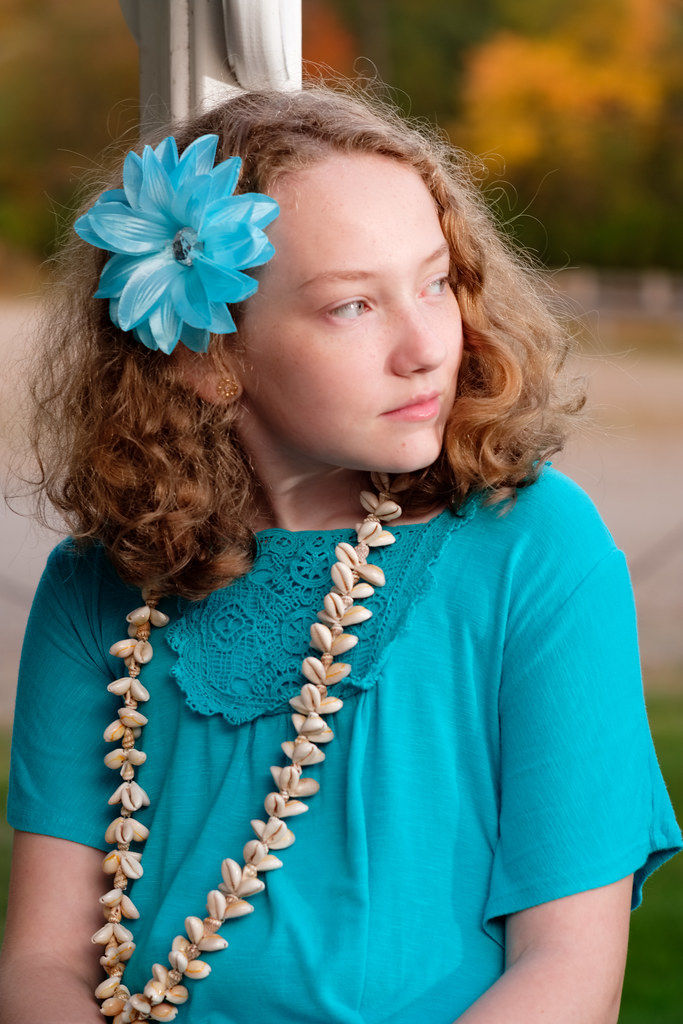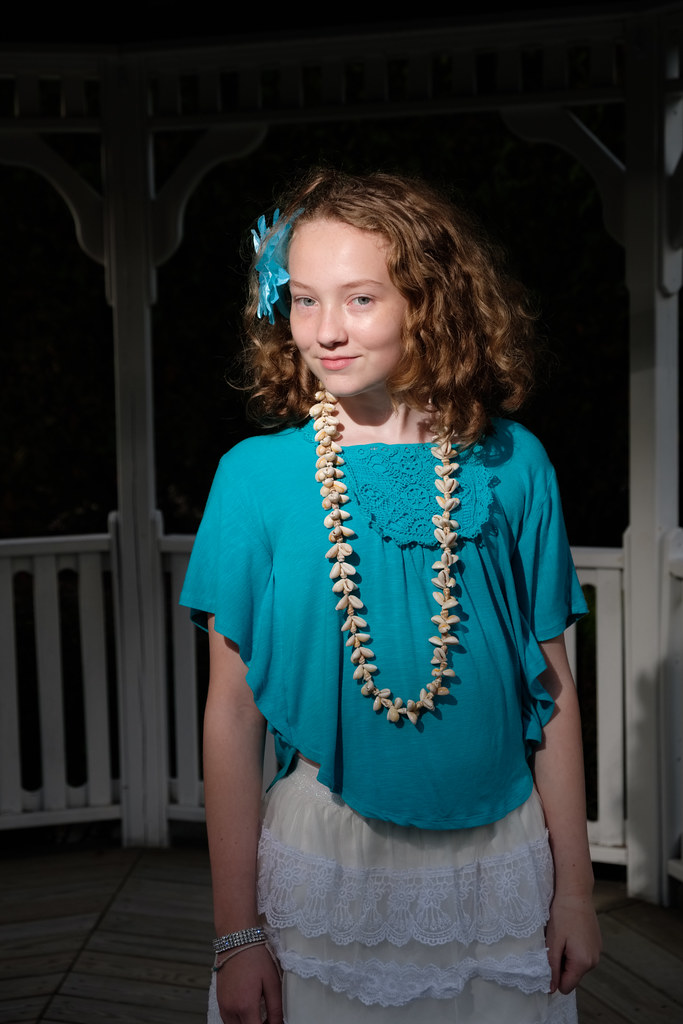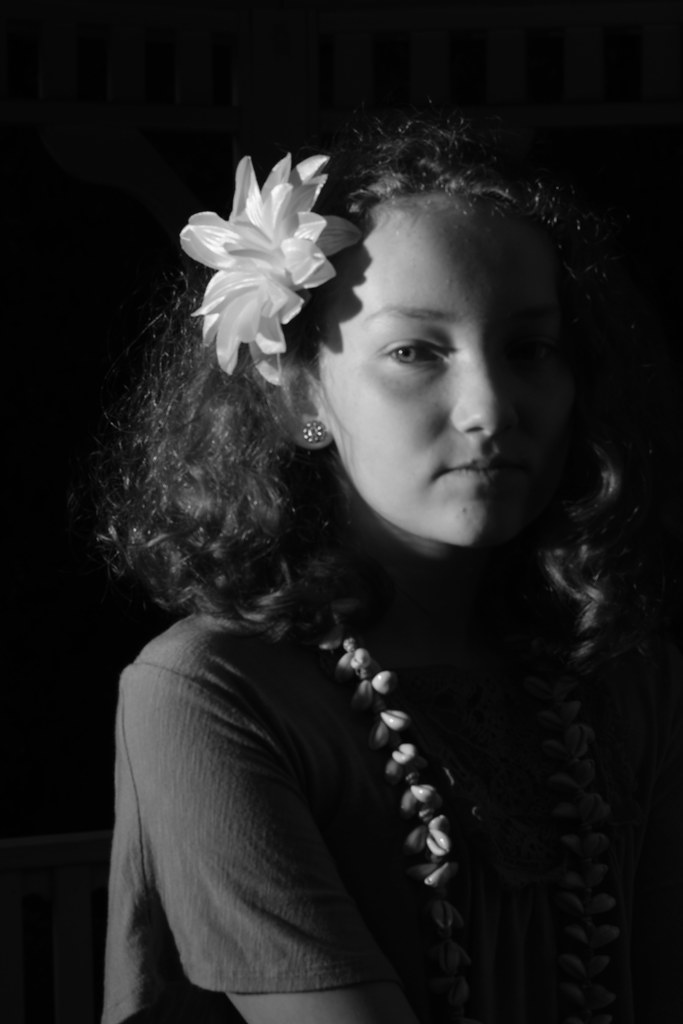shawn
Mentor
And if you want to do the new flash fad of 'beating the sun', it is just as easy to use a ND filter. They cost less than an HHS flash, but they don't have the screen interface of a new flash.
Here is beating the sun using an 3 stop ND filter:
How does a ND filter help 'beat the sun?' The point of a HSS flash is you shoot at a higher shutter speed so that you reduces the suns input on exposure without effecting the output of the flash, assuming the flash is faster than the shutter speed. You are changing the ratio of the sun to the flash. A ND filter will just cut down the flash and the sun together without altering the ratio between them.
If your flash is strong enough the other option is just to overpower it.
For example this is with pretty typical fill flash:

and these are from the same time 'beating the sun' by turning up the output and using a snoot.


That is with a Flashpoint StreakLight 360 Ws.
Shawn
Hari
Well-known
I'm getting the Rollei bulb flasher working,
I've got a bunch of bullb. Looking for
the strange battery.
I've got a bunch of bullb. Looking for
the strange battery.
Hari
Well-known
Plus if I want electronic flash, I use Nikon SB-4
with a cord.
with a cord.
Robert Lai
Well-known
Batteries for bulb flashes
Batteries for bulb flashes
Most bulb flash units use a 22.5 V battery A221 /505A, for example this one:
https://www.newegg.com/p/14R-0025-00H37#
(I have no connection with the seller, just showing an example).
The other alternative is a 15V battery 504/ Neda 220
http://www.batteriesinaflash.com/ex...MIibmjkMTv7QIVENvACh25LAJYEAQYASABEgIhJvD_BwE
For the latter, I can often substitute a 12V A23 battery. These are available at Walmart for little money. Often, you can use pliers and adjust the contacts in the battery compartment to allow these smaller batteries to fit.\
https://www.amazon.com/AmazonBasics...+opener&qid=1609119371&sr=8-8&tag=googhydr-20
Batteries for bulb flashes
Most bulb flash units use a 22.5 V battery A221 /505A, for example this one:
https://www.newegg.com/p/14R-0025-00H37#
(I have no connection with the seller, just showing an example).
The other alternative is a 15V battery 504/ Neda 220
http://www.batteriesinaflash.com/ex...MIibmjkMTv7QIVENvACh25LAJYEAQYASABEgIhJvD_BwE
For the latter, I can often substitute a 12V A23 battery. These are available at Walmart for little money. Often, you can use pliers and adjust the contacts in the battery compartment to allow these smaller batteries to fit.\
https://www.amazon.com/AmazonBasics...+opener&qid=1609119371&sr=8-8&tag=googhydr-20
charjohncarter
Mentor
How does a ND filter help 'beat the sun?' The point of a HSS flash is you shoot at a higher shutter speed so that you reduces the suns input on exposure without effecting the output of the flash, assuming the flash is faster than the shutter speed. You are changing the ratio of the sun to the flash. A ND filter will just cut down the flash and the sun together without altering the ratio between them.
If your flash is strong enough the other option is just to overpower it.
For example this is with pretty typical fill flash:

and these are from the same time 'beating the sun' by turning up the output and using a snoot.


That is with a Flashpoint StreakLight 360 Ws.
Shawn
If you want to try the latest fad to to 'you tube' it has all the latest.
https://www.youtube.com/results?search_query=beating+the+sun+with+nd+filters
It is a choice, you can think for yourself. I just don't like spending a half day with my friend showing how to 'beat the sun' with his HSS flash and he is still calling me about it.
Robert Lai
Well-known
Rolleiflash comb?
Rolleiflash comb?
Hari,
If you're thinking of the Rolleiflash that mounts on the Rolleiflex TLR lens mount, then it needs a rectangular 22.5 V battery such as the Exell 412 A.
https://www.amazon.com/AmazonBasics...+opener&qid=1609119371&sr=8-8&tag=googhydr-20
However, I've found that I can usually use the cylindrical 22.5 battery, and just keep it in position with some double sided tape.
Rolleiflash comb?
Hari,
If you're thinking of the Rolleiflash that mounts on the Rolleiflex TLR lens mount, then it needs a rectangular 22.5 V battery such as the Exell 412 A.
https://www.amazon.com/AmazonBasics...+opener&qid=1609119371&sr=8-8&tag=googhydr-20
However, I've found that I can usually use the cylindrical 22.5 battery, and just keep it in position with some double sided tape.
shawn
Mentor
If you want to try the latest fad to to 'you tube' it has all the latest.
https://www.youtube.com/results?search_query=beating+the+sun+with+nd+filters
It is a choice, you can think for yourself. I just don't like spending a half day with my friend showing how to 'beat the sun' with his HSS flash and he is still calling me about it.
The links you posted were about using a ND filters for long exposures in sun. That is obvious. Or for shooting wide open in bright sun, again obvious. Or for video using a filter to keep the shutter speed close to the frame rate for smoother footage.
ND filters don't let one 'beat the sun' with flash photography. A ND filter lowers the sun and the flash the same amount. A ND filter is not a substitute for HSS or for a more powerful flash.
Shawn
charjohncarter
Mentor
The links you posted were about using a ND filters for long exposures in sun. That is obvious. Or for shooting wide open in bright sun, again obvious. Or for video using a filter to keep the shutter speed close to the frame rate for smoother footage.
ND filters don't let one 'beat the sun' with flash photography. A ND filter lowers the sun and the flash the same amount. A ND filter is not a substitute for HSS or for a more powerful flash.
Shawn
It depends on how crazy you want to be.
https://www.youtube.com/watch?v=TCb5Yu6p15E
David Hughes
David Hughes
Oddly enough, the other day, I was thinking about all those excellent flashes Metz and Vivitar used to make and so looked on ebay and was shocked at a) how dirt cheap they were and b) that no one was buying them.
So I monitored 1 or 2 and was shocked that a Vivitar offered with all the bits and the manual was offered for just under two pounds and no one bought it. Even dedicated Metz and Olympus digital ones were being ignored.
I guess that they have to be priced at several hundred these days to be taken seriously.
Regards, David
So I monitored 1 or 2 and was shocked that a Vivitar offered with all the bits and the manual was offered for just under two pounds and no one bought it. Even dedicated Metz and Olympus digital ones were being ignored.
I guess that they have to be priced at several hundred these days to be taken seriously.
Regards, David
Jamie123
Mentor
So I monitored 1 or 2 and was shocked that a Vivitar offered with all the bits and the manual was offered for just under two pounds and no one bought it. Even dedicated Metz and Olympus digital ones were being ignored.
I guess that they have to be priced at several hundred these days to be taken seriously.
Regards, David
I think it's safe to say that the vast majority of flash users are shooting digitally and are most likely opting for the offerings of their camera's brand (Canon, Nikon, etc.). For the rest (e.g. people who use flash with mechanical film cameras), the supply vastly outnumbers the demand so it's understandable that the prices are low. Unless you have heavily invested in Vivitar flashes in the past, I don't see this as a bad thing
David Hughes
David Hughes
I think it's safe to say that the vast majority of flash users are shooting digitally and are most likely opting for the offerings of their camera's brand (Canon, Nikon, etc.). For the rest (e.g. people who use flash with mechanical film cameras), the supply vastly outnumbers the demand so it's understandable that the prices are low. Unless you have heavily invested in Vivitar flashes in the past, I don't see this as a bad thing
I think the supply of old digital ones (Metz etc) out numbers demand and so am amazed at the prices people will pay for new ones.
Regards, David
charjohncarter
Mentor
I just went on US ebay. 26 units many of them the shipping was more than the unit price; these were my favorite flash a Minolta 320x. I have five or six already but some are tempting.
Shafovaloff1
Well-known
Flashes on ebay are cheap except, find the dedicated one for the CLE.... Of course the Minolta "X" series flashes will function just as well as the "Auto Electroflash CLE" or so says the book. I use the older small electronic flashes when the finder film LED lights stop working and after firing a few times everything is back to normal. My suspicion is that the contact for the flash under the shoe, on the electronic board just under it, oxidizes and the more power somehow overcomes the oxidation. Nothing had fried yet knock on wood!
madNbad
Well-known
Back to the original topic, I did like the M6 TTLs' flashing lightning bolt to confirm proper exposure.
hap
Well-known
Most bulb flash units use a 22.5 V battery A221 /505A, for example this one:
https://www.newegg.com/p/14R-0025-00H37#
(I have no connection with the seller, just showing an example).
The other alternative is a 15V battery 504/ Neda 220
http://www.batteriesinaflash.com/ex...MIibmjkMTv7QIVENvACh25LAJYEAQYASABEgIhJvD_BwE
For the latter, I can often substitute a 12V A23 battery. These are available at Walmart for little money. Often, you can use pliers and adjust the contacts in the battery compartment to allow these smaller batteries to fit.\
https://www.amazon.com/AmazonBasics...+opener&qid=1609119371&sr=8-8&tag=googhydr-20
Thanks, very helpful.
hap
Well-known
I just went on US ebay. 26 units many of them the shipping was more than the unit price; these were my favorite flash a Minolta 320x. I have five or six already but some are tempting.
A common trick/scam. I just ordered a 4 dollar filter...and 10$ mailing fee. Filter 25.5mm so could put in a tiny mailing pouch with two stamps.
Bill Clark
Mentor
Light is a very important ingredient for photography. So is using shadow.
Study lighting patterns. Some will help, giving the illusion of three dimensions, while using only two.
Learn how to work with and incorporate the most flattering positions showing the human body, including the face when making photographs.
On camera flash is like deer in the headlights.
Learn how to sculpt using light. Get the flash off of the camera. Use light stands for the flash. Pocket Wizards or something like them to remotely fire the flash. Consider using reflectors instead of electronic flash.
I don’t use ttl flash. I found it can be fooled. And I want to use light as I see fit with my photography.
Smiles and good luck.
Study lighting patterns. Some will help, giving the illusion of three dimensions, while using only two.
Learn how to work with and incorporate the most flattering positions showing the human body, including the face when making photographs.
On camera flash is like deer in the headlights.
Learn how to sculpt using light. Get the flash off of the camera. Use light stands for the flash. Pocket Wizards or something like them to remotely fire the flash. Consider using reflectors instead of electronic flash.
I don’t use ttl flash. I found it can be fooled. And I want to use light as I see fit with my photography.
Smiles and good luck.
Folks, after all this discussion
I am still mystified at the apparent lack of popularity for Leica M film TTL flash.
Did it not work that well?
Auto Thyrister flash works just as well?
Or did Leica's "simpler is better mechandising" convince Leica newbies advanced technology is bad?
I am still mystified at the apparent lack of popularity for Leica M film TTL flash.
Did it not work that well?
Auto Thyrister flash works just as well?
Or did Leica's "simpler is better mechandising" convince Leica newbies advanced technology is bad?
dof
Fiat Lux
Folks, after all this discussion
I am still mystified at the apparent lack of popularity for Leica M film TTL flash.
Did it not work that well?
Auto Thyrister flash works just as well?
Or did Leica's "simpler is better mechandising" convince Leica newbies advanced technology is bad?
I'm likely among a small set of folks who's only rangefinder cameras happen to be the M6 TTL and the CLE. While I've never used flash on the CLE, the flash circuit in the M6 TTL has worked terrifically in my experience.
I suspect that there weren't more has to do with TTL flash exposure being a relatively new feature at the same time that new film rangefinder body introductions began slowing down. Leica wanted to market the MP (and by extension the MA) as "heritage" products and it appears their customers love it. The M7 retains as much of that "simpler is better merchandising"/engineering tradition as possible, while offering some useful automation. That would seem to be as much automation as their film customers need. There was no need for further evolution with film-based M bodies.
At the same time, the need to transition to digital bodies became paramount across the industry. TTL flash metering was moved forward in the Leica digital bodies.
Back to film, the Contax G1 & G2 also feature TTL flash metering. That leaves out the Konica & Cosina/Voigtlander bodies in terms of post-1990 designs that chose to leave it out. Am I missing any others?
madNbad
Well-known
Folks, after all this discussion
I am still mystified at the apparent lack of popularity for Leica M film TTL flash.
Did it not work that well?
Auto Thyristor flash works just as well?
Or did Leica's "simpler is better merchandising" convince Leica newbies advanced technology is bad?
First off, at best the M6 TTL was using mid 1990s' technology. Then there was only Metz making flashes that were compatible with it. The M7 brought HSS but the only flash that would work was made by Metz. The lure of TTL flashes is the ability to use multiple units that communicate with each other. The 54 series with the appropriate modules are still line of sight units that have been supplanted by radio control. Most Leica owners are using a flash for fill, in which case the modern thyristor is all that is necessary. I mentioned the lack of a swiveling reflector on both the SF-20 and SF-24d. If you're going to spend several hundred dollars on a shoe mount flash, shouldn't it include a feature universally available on so many other, less expensive units? If Leica had felt TTL was important to their customers, both they and Metz would have taken steps to produce more efficient, less bulky units and it would have been a feature of the MP. Other companies would have stepped up to make units that were compatible but less pricy but the shift to digital changed the focus. TTL and Leica film cameras were a one off, much like the M5. I liked and used the M6 TTL with multiple flashes and it did work well but not so much better than a LumoPro with a radio trigger.
Share:
-
This site uses cookies to help personalise content, tailor your experience and to keep you logged in if you register.
By continuing to use this site, you are consenting to our use of cookies.

